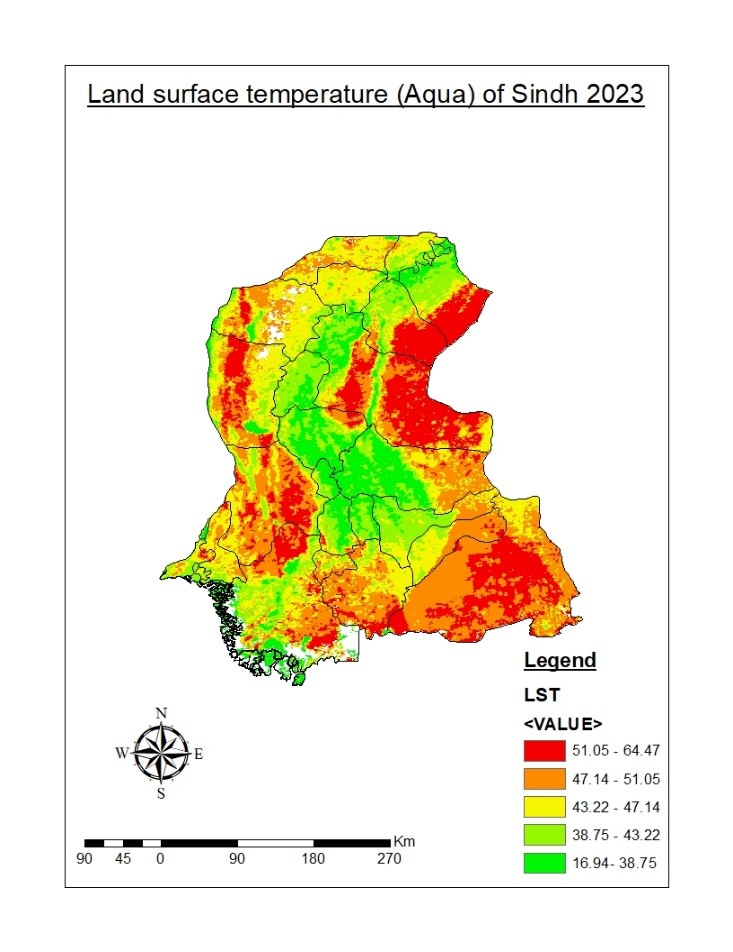Spatial Assessment of Atmospheric Contamination and Urban Heat Phenomenon in Urban Centers of Sindh, Pakistan
Keywords:
Air Pollution, Urban Heat Island, climate change, Spatial Analysis, UrbanizationAbstract
Rapid urbanization and industrialization in Sindh, Pakistan, particularly in urban centers like Karachi, have led to significant challenges related to air pollution and climate change. This study uses Geographic Information Systems (GIS) to analyze air quality indices (AQI) in Sindh, focusing on particulate matter such as PM2.5. It offers a novel approach by visually mapping the spatial patterns and potential correlations between air pollution and temperature, a topic not extensively covered before. Through interpolation methods and temporal graphing of AQI values, the study identifies areas with high air pollution and examines their spatial distribution throughout the year. The comparison of PM2.5 concentrations with land surface temperature (LST) maps reveals patterns where higher pollution levels often align with urban centers, intensifying the urban heat island effect due to excess heat generated by human activities. Beyond impacting human health, air pollution affects ecosystems, soil, water, and biodiversity. The study highlights how areas with significant air pollution tend to have higher surface temperatures, indicating a direct link between pollution and temperature increases. However, the relationship is complex, as the effects of air pollution on climate are influenced by factors like geographic location, meteorological conditions, and pollutant composition. This research provides valuable insights into the spatial dynamics of atmospheric contamination and its implications for urban heat formation in Sindh, enhancing the understanding of how human activities, air quality, and climate change interact.
References
Moyebi, O. D., Sannoh, F., Fatmi, Z., Siddique, A., Khan, K., Zeb, J., Hussain, M. M., Carpenter, D. O., & Khwaja, H. A. (2023). State of gaseous air pollutants and resulting health effects in Karachi, Pakistan. Environmental Research. [https://pubmed.ncbi.nlm.nih.gov/36602617/]
Idrees, M., Nergis, Y., & Irfan, M. (2023). Industrial emission monitoring and assessment of air quality in Karachi coastal city, Pakistan. *Atmosphere, 14*(10), 1515. [https://www.mdpi.com/2073-4433/14/10/1515]
Roman, S., & Idrees, M. (2013). Urban air pollution: A case study of Faisalabad, Pakistan. Journal of Chemical Society of Pakistan, 35*(6), 1505-1512. [https://www.ncbi.nlm.nih.gov/pmc/articles/PMC8498981/]
Mayer, H. (1999). Air pollution in cities. *Atmospheric Environment, 33*(24-25), 4029-4037. (https://doi.org/10.1016/S1352-2310(99)00144-2)
Atmospheric Environment. (1996). Urban air pollution in megacities of the world. (https://www.sciencedirect.com/science/article/pii/135223109500)
Wang, S., Gao, S., Li, S., & Feng, K. (2019). Strategizing the relation between urbanization and air pollution: Empirical evidence from global countries. *Journal of Cleaner Production, 238*, 117802. (https://www.sciencedirect.com/science/article/abs/pii/S0959652619334857)
Arif, G. M., Sadiq, M., Sathar, Z., Jiang, L., & Hussain, S. (2024). Has urbanization slowed down in Pakistan? *Asian Population Studies, 20*(1), 56-72. [https://www.tandfonline.com/doi/full/10.1080/17441730.2022.2156508] (https://www.tandfonline.com/doi/full/10.1080/17441730.2022.2156508)
Wang, Y., Liu, Y., Wang, S., Meng, X., Xue, X., & Hou, X. (2020). The impact of urbanization on air quality in Chinese cities: A case study of five cities. *International Journal of Environmental Research and Public Health, 17*(2), 460. (https://www.mdpi.com/1660-4601/17/2/460)
Hanif, U. (2017). Socio-economic impacts of heat wave in Sindh. *Journal of Environmental Studies, 13*(26), January (https://www.prdb.pk/article/socio-economic-impacts-of-heat-wave-in-sindh-8850)
Lanjwani, M. U., Lanjwani, M. F., Hussain, M., & Sodhar, K. (2024). Impact of urbanization on urban heat island intensity: A case study of Larkana city, Sindh, Pakistan. Theoretical and Applied Climatology. (https://link.springer.com/article/10.1007/s00704-024-04981-z)
Arshad, S., Ahmad, S. R., Abbas, S., Asharf, A., Siddiqui, N. A., & Islam, Z. U. (2022). Quantifying the contribution of diminishing green spaces and urban sprawl to urban heat island effect in a rapidly urbanizing metropolitan city of Pakistan. Land Use Policy, 113, 105874. (https://www.sciencedirect.com/science/article/pii/S0264837721005040)
Zhang, J., Yang, W., & Li, M. (2021). The influence of urban green spaces on urban heat island intensity and microclimate regulation: A case study of Xuzhou, China. ISPRS International Journal of Geo-Information, 10*(8), 539. [https://www.mdpi.com/2220-9964/10/8/539] (https://www.mdpi.com/2220-9964/10/8/539)
Yaseen, M., Serafimovich, A., Shakoor, A., Cherenkov, A., & Latif, A. (2024). Urban climate dynamics and thermal comfort in the metropolitan region of Lahore, Pakistan: A case study. Theoretical and Applied Climatology. (https://link.springer.com/article/10.1007/s00704-024-04981-z)
Pakistan Bureau of Statistics. (2017) Population Census of Pakistan. Retrieved from file:///C:/Users/AA%20COMPUTER/Downloads/population%20census.pdf
Germanwatch. (2020). World map of the global climate risk index 2000 – 2019. Retrieved from (https://www.germanwatch.org/en/cri)
United States Geological Survey. MODIS data. Retrieved from [https://www.usgs.gov/centers/eros/science/modis]

Downloads
Published
How to Cite
Issue
Section
License
Copyright (c) 2024 50SEA

This work is licensed under a Creative Commons Attribution 4.0 International License.




















